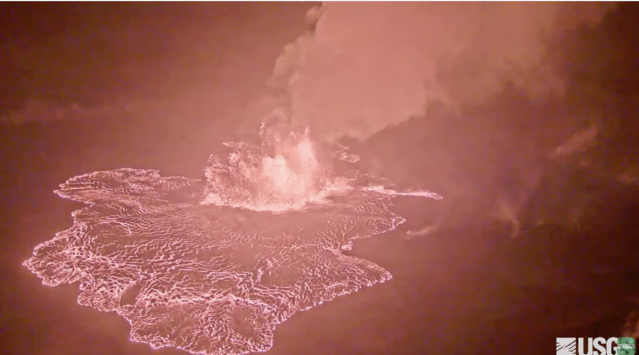Description

Disclaimer: Copyright infringement not intended
Context
- The Kilauea volcano on Hawaii’s Big Island erupted early on Wednesday morning, according to an advisory from the U.S. Geological Survey (USGS).
About Kilauea Volcano
- Kilauea Volcano is an active shield volcano located on the Big Island of Hawaii.
- It is one of the most active volcanoes in the world and has been continuously erupting since 1983.
Location and Geography:
- Kilauea is situated in the southeastern part of the island of Hawaii.
- It is part of the Hawaii Volcanoes National Park.
- The volcano rises 4,091 feet (1,247 meters) above sea level.
Eruption History:
- Continuous Eruption: Kilauea has been erupting continuously since January 3, 1983, making it one of the longest-lasting eruptions in recorded history.
- Lava Flows: The volcano has produced extensive lava flows that have covered large areas of land, including residential areas and roads.
- Pu'u 'O'o and Halema'uma'u: The eruption has created two prominent vents, namely Pu'u 'O'o and Halema'uma'u, which have been the main sources of lava flows and volcanic activity.
Types of Eruptions:
- Effusive Eruptions: Kilauea is known for its effusive eruptions, characterized by the slow release of lava. These eruptions are generally less explosive compared to other types of volcanoes.
- Lava Fountains: Occasionally, the volcano experiences explosive eruptions with lava fountains shooting high into the air.
Impact and Hazards:
- Lava Flows: The lava flows from Kilauea have destroyed homes, roads, and infrastructure, displacing local residents.
- Volcanic Gases: The volcano emits various gases, including sulfur dioxide, which can pose health risks to people living in the vicinity.
- Vog: Volcanic smog, known as "vog," is created when volcanic gases mix with atmospheric pollutants and can affect air quality downwind of the volcano.
Monitoring and Research:
- Hawaiian Volcano Observatory (HVO): The HVO, part of the U.S. Geological Survey (USGS), closely monitors Kilauea's volcanic activity to provide timely warnings and updates to the public.
- Seismic Monitoring: Scientists use seismographs to measure ground vibrations and detect any changes that could indicate volcanic activity.
- Gas Sampling: Sampling equipment is used to collect gas samples to monitor changes in gas composition, which can provide insights into the volcano's behavior.
Tourism and Visitor Center:
- Jaggar Museum: The Thomas A. Jaggar Museum, located within the Hawaii Volcanoes National Park, offers exhibits and information about Kilauea's geology, history, and ongoing volcanic activity.
- Crater Rim Drive: Visitors can take a scenic drive along the Crater Rim, which offers panoramic views of the volcano and its surrounding landscape.
- Volcano Tours: Guided tours are available for visitors to explore the volcanic features and learn about the unique ecosystems that have developed around the volcano.
|
PRACTICE QUESTION
Q) Consider the following statements about lavas:
1. Basic lavas are very explosive in nature
2. Acidic lavas have low silica content and they travel long distances before cooling down
3. Basic lavas crystallize and form granite rocks
Choose the correct options:
A. 1 only
B. 1 and 2 only
C. All of the above
4. None
Answer: D
|

https://indianexpress.com/article/world/kilauea-volcano-erupts-hawaiis-big-island-8651199/











